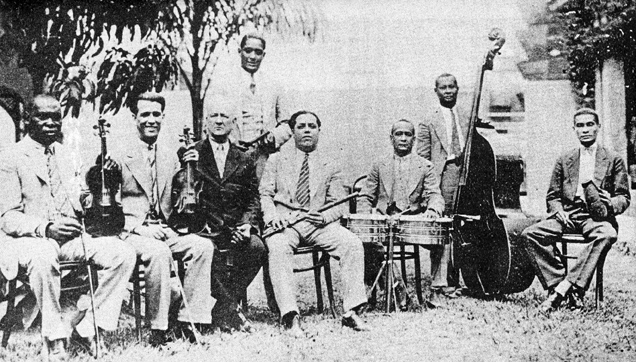
ダンソン・マンボとチャンガ
Danzón-mambo and Changa

Orquesta de Antonio María Romeu, founded in 1910 (photo is later). It was one of the first charanga francesas.
ダンソンマンボ(ダンソン・デ・ヌエボ・リトモとも呼ばれる)は、 キューバ舞踊音楽のサブジャンルで、古典的なダンソンからマンボやチャチャチャへの移行 を示すものである。また、チャランガと呼ばれるキューバ舞踊団の形式が現在の形になったのも、ダンソン-マンボの文脈からである。
| The danzón-mambo (also known as danzón de
nuevo ritmo) is a subgenre of Cuban dance music that marked the
transition from the classical danzόn to the mambo and the cha-cha-chá.
It was also in the context of the danzón-mambo that the Cuban dance
band format called charanga
reached its present form. |
ダンソンマンボ(ダンソン・デ・ヌエボ・リトモとも呼ばれる)は、
キューバ舞踊音楽のサブジャンルで、古典的なダンソンからマンボやチャチャチャへの移行
を示すものである。また、チャランガと呼ばれるキューバ舞踊団の形式が現在の形になったのも、ダンソン-マンボの文脈からである。 |
| Origins The danzón-mambo was created by the musicians and arrangers of Antonio Arcaño's charanga, Arcaño y sus Maravillas, which was founded in 1937 (Orovio 1981:324). According to Santos (1982), The main forces behind Arcano's mambo were the Lopez brothers, Orestes ... and Israel (the great "Cachao") ..., who did most of the composing and arranging for the group, and played the 'cello and the string bass, respectively. |
起源 ダンソンマンボは、1937年に結成されたアントニオ・アルカーニョのチャランガ「アルカーニョ・イ・スス・マラビージャス」のミュージシャンやアレン ジャーによって創作された(オロビオ 1981:324)。Santos(1982)によれば アルカーニョのマンボの主役は、ロペス兄弟、オレステス...とイスラエル(偉大な 「カチャオ」)...であり、彼らはグループのためにほとんどの作曲と編曲を行い、それぞれチェロと弦楽ベースを演奏した。 |
| Characteristics Generally speaking, the danzón-mambo represents a further and stronger incorporation of elements of the son into the danzón. The first sections, or danzones, did not depart significantly from the traditional danzón structure [1]. But, the final section of the danzón-mambo was based on tumbaos and guajeos from the montuno section of the son, which created a complex, clave-oriented polyphony with strong accents on the upbeat (Santos 1982). In order to further reinforce the son feeling, Arcaño added the tumbadora (conga drum) to the traditional charanga percussion lineup of pailas and güiro. Also, the paila player began to use a cowbell in the final section (Santos 1982). This final section, at first called nuevo ritmo, later came to be called mambo.[1] |
特徴 一般的に言って、ダンソン・マンボは、息子の要素をダンソンにさらに強く取り入れたものである。最初のセクション(ダンゾーン)は、伝統的なダンソンの構 成から大きく逸脱することはなかった[1]。しかし、ダンソン-マンボの最後のセクションは、ソンのモントゥーノ・セクションのトゥンバオとグアヘオに基 づいており、アップビートに強いアクセントを持つ複雑なクラーヴェ志向のポリフォニーを作り出している(Santos 1982)。アルカーニョは、ソンのフィーリングをさらに強化するために、パイラスとグイロという伝統的なチャランガ打楽器のラインナップにトゥンバドー ラ(コンガ・ドラム)を加えた。また、パイラ奏者は最後のセクションでカウベルを使うようになった(Santos 1982)。この最終セクションは、最初はヌエボ・リトモと呼ばれていたが、後にマンボと呼ばれるようになった[1]。 |
| Later development Out of the danzón-mambo came both the mambo and the cha-cha-chá. The mambo would subsequently become a genre played mainly by American-style big bands, and as such, did not pose a threat to the danzón-mambo. But, in the face of the sudden overwhelming popularity of the cha-cha-chá in the 1950s, the danzón-mambo began to disappear. However, a convention arose of playing the final section of the danzón-mambo with a cha-cha-chá rhythm, enabling the dancers to dance both the danzón and the cha-cha-chá in the course of the same composition. This became known as the danzón-cha and is the form of danzón most favored by dancers in Cuba at present. Discography The Cuban Danzon: Its Ancestors and Descendants 1982. Various Artists. Folkways Records FW04066. De Nuevo El Monarca. 1993. Antonio Arcaño y sus Maravillas. ARTEX CD-069. |
その後の発展 ダンソンマンボからマンボとチャチャチャが生まれた。マンボはその後、主にアメリカン・ スタイルのビッグバンドが演奏するジャンルとなり、ダンソンマンボを脅かす存在にはならなかった。しかし、1950年代に突然チャチャチャが圧倒的な人気 を獲得したため、ダンソンマンボは姿を消し始めた。しかし、ダンソンマンボの最後の部分をチャ・チャ・チャのリズムで演奏する慣習が生まれ、ダンサーは同 じ曲の中でダンソンとチャ・チャ・チャの両方を踊ることができるようになった。これがダンソン・チャとして知られるようになり、現在キューバで最も好まれ ているダンソンの形式である。 |
| https://en.wikipedia.org/wiki/Danz%C3%B3n-mambo |
|
| Charanga
is a traditional ensemble that plays Cuban dance music. They made Cuban
dance music popular in the 1940s and their music consisted of heavily
son-influenced material, performed on European instruments such as
violin and flute by a Charanga orchestra. (Chomsky 2004, p. 199). The
style of music that is most associated with a Charanga is termed
'Danzón', and is an amalgam of both European classical music and
African rhythms. |
チャランガはキューバのダンス音楽を演奏する伝統的なアンサンブルであ
る。彼らは1940年代にキューバのダンス・ミュージックを流行らせ、その音楽はヴァイオリンやフルートといったヨーロッパの楽器をチャランガ楽団が演奏
する、ソンの影響を強く受けたもので構成されていた。(Chomsky 2004, p.
199)。チャランガから最も連想される音楽のスタイルは「ダンソン」と呼ばれ、ヨーロッパのクラシック音楽とアフリカのリズムの融合である。 |
| Origins "Scholars agree that Spain and parts of West and Central Africa provided the most crucial influences in the development of Cuban popular and religious music. But in the case of charanga, the contributions of French and Haitian influences cannot be ignored. Charanga began its history in the early nineteenth century when Haitians, both African and French, escaped the island's revolution. They brought with them a love for the French contredanse, a multi-sectional dance form that evolved into the danzón, the quintessential charanga style. Both were performed by an ensemble called an orquesta típica, a group with brass, woodwinds and timpani that performed outdoors. When the upper classes decided to dance indoors, the instrumentation was radically altered. The new ensemble was called charanga francesa. Although the word francesa literally means "French", it was used in nineteenth-century Cuba more specifically as a name for Haitian Creoles. In the charanga francesa, flutes and strings replaced the brass and woodwinds of the orquesta típica, and a small drum kit called pailas (now called timbales) replaced the booming tympany. While the orquesta típica was raucous in a New Orleans jazz fashion, the charanga francesa produced a light and somewhat effete music. The French influence extends to instrumentation for the modern charanga is based on charanga francesa."[1]  Orquesta de Antonio María Romeu, founded in 1910 (photo is later). It was one of the first charanga francesas. The first charanga francesa in Cuba was formed at the turn of the twentieth century, possibly by Antonio (Papaíto) Torroella (1856–1934), whose orchestra was active by 1894. These orchestras play lighter versions of the danzón without a brass section and emphasizing flutes, violins, and piano. The percussion was provided by pailas criollas, now known as timbales. The style continued into the 1940s with flautist Antonio Arcaño and his Maravillas (Morales 2003 p13). Charangas are still widespread today, though the danzón is considered old-fashioned. |
起源 「キューバのポピュラー音楽と宗教音楽の発展において、最も決定的な影響を与えたのはスペインと西アフリカと中央アフリカの一部であるというのが学者の一 致した見解だ。しかし、チャランガの場合、フランスとハイチの影響を無視することはできない。チャランガの歴史は19世紀初頭、アフリカ系とフランス系の ハイチ人が島の革命を逃れてきたときに始まった。彼らは、チャランガの真髄であるダンソンへと発展した、複数のセクションを持つフランス式ダンス、コント ルダンスへの愛情を持ち込んだ。どちらも、オルケスタ・ティピカと呼ばれる金管楽器、木管楽器、ティンパニを使ったアンサンブルで、屋外で演奏された。上 流階級が屋内で踊ることを決めたとき、楽器編成は根本的に変更された。新しいアンサンブルは、チャランガ・フランセーサと呼ばれた。フランチェッサという 言葉は文字通り「フランス人」という意味だが、19世紀のキューバではハイチ系クレオールの呼称としてより具体的に使われていた。チャランガ・フランセー サでは、フルートと弦楽器がオルケスタ・ティピカの金管楽器と木管楽器に取って代わり、パイラス(現在はティンバレスと呼ばれる)と呼ばれる小型のドラム キットがけたたましいティンパニーの代わりを務めた。オルケスタ・ティピカがニューオリンズ・ジャズ風に騒々しかったのに対して、チャランガ・フランセー サは軽快でやや上品な音楽を生み出した。フランスの影響は楽器編成にも及んでおり、現代のチャランガはチャランガ・フランセーサを基にしている」[1]。  アントニオ・マリア・ロメウ管弦楽団、1910年創立(写真は後日)。最初のチャランガ・フランセーサの一つである。 キューバで最初のチャランガ・フランセーサは20世紀初頭に結成され、おそらくアントニオ(パパイト)・トロエラ(1856-1934)によって1894 年までに活動した。これらのオーケストラは、金管セクションを持たず、フルート、ヴァイオリン、ピアノを強調した軽めのバージョンのダンソンを演奏した。 パーカッションは、現在ティンバレスとして知られるパイラス・クリオージャが担当した。このスタイルは、フルート奏者のアントニオ・アルカーニョと彼のマ ラビージャスによって1940年代まで続いた(Morales 2003 p13)。チャランガは今日でも広く普及しているが、ダンソンは古臭いものと考えられている。 |
| Danzón Music of Haiti French contredanse La tumba francesa Mambo Twoubadou |
ダンソン ハイチの音楽 フランスのコントレダンス ラ・トゥンバ・フランセーズ マンボ トゥバドゥ |
| Chomsky, Aviva (2004). The Cuba
Reader: History, Culture, Politics. ISBN 0-8223-3197-7. Morales, Ed (2003). The Latin Beat: The Rhythms and Roots of Latin Music, from Bossa Nova to Salsa and Beyond. ISBN 0-306-81018-2. |
|
| https://en.wikipedia.org/wiki/Charanga_(Cuba) |
|
リ ンク
文 献
そ の他の情報
Copyleft, CC, Mitzub'ixi Quq Chi'j, 1996-2099
☆
 ☆
☆